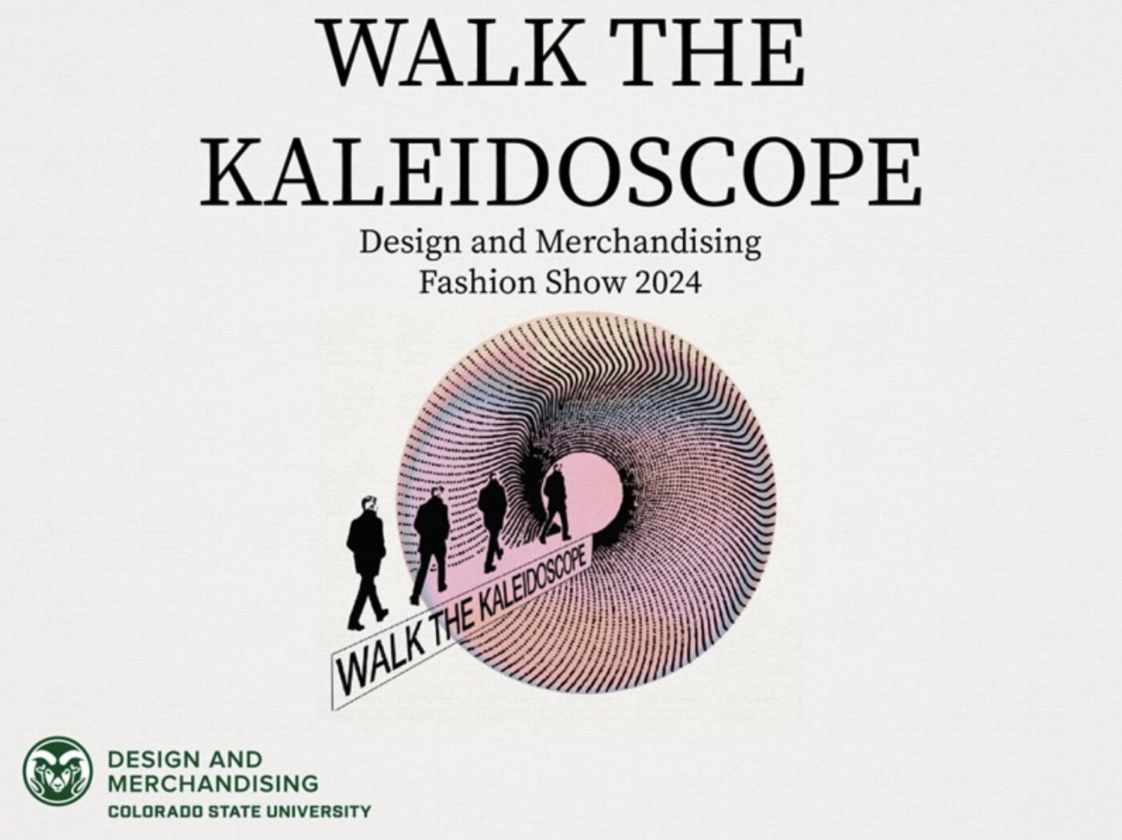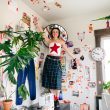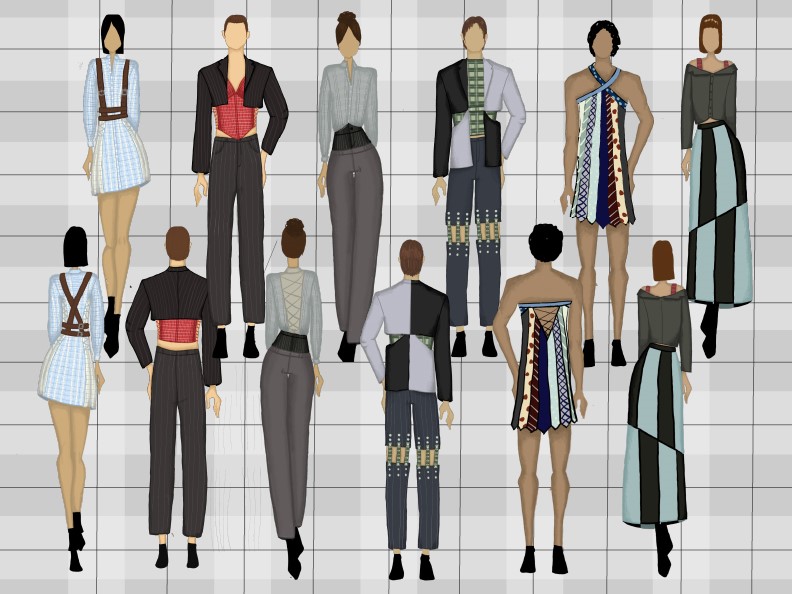Mark your calendars — the Colorado State University (CSU) Department of Design and Merchandising Fashion Show is back. The “Walk the Kaleidoscope” Fashion Show occurs on Friday, May 3 at 7:30 p.m. at the Lory Student Center Grand Ballroom in Fort Collins.
More than 100 models will strut their stuff, showcasing signature collections created by 17 graduating students from the Apparel Design and Production Concentration.
The collections, which were created during the students’ senior capstone course, will be judged on two categories: construction and marketability. In the end, the judges will announce their overall pick.

From ideation to execution, “Walk the Kaleidoscope” is produced and promoted by students enrolled in DM 474: Fashion Show Production and Event Planning. Students work in one of four committees: Garment & Modeling, Promotions & Publicity, Sponsorships & VIP Reception, and Set & Stage Design.
“The kaleidoscope represents a different pattern, different colors and different walks of life,” said Promotions & Publicity committee members Caitlin Fuller and Mia Mazokopos. “It’s supposed to encapsulate everything in a way. It’s a very intricate, unique and diverse picture. That was how we decided the theme.”
Tickets are available now — student tickets are $20 while general admission is $30. VIP tickets are also available for purchase for $75, which includes access to a VIP reception beginning at 5 p.m. as well as premium seating. Several sponsor and donation opportunities are open for businesses and individuals to support the fashion show.
Meet The Designers
Juliet Babyak | Trousseau
Like William Shakespeare’s female protagonist in Romeo and Juliet, Juliet Babyak is a hopeless romantic. Her collection, Trousseau, under her brand Capulet, is a bridal trundle collection inspired by romantic, feminine design characteristics under a circular fashion cycle.
The sustainable line showcases how significant milestone garments, such as wedding dresses, can be given new life and purpose even after the special event. Babyak used traditional and new methods of design to illustrate the possibilities of what can be upcycled from gowns. She hand-dyed silk, 3D-printed appliques, printed her own fabric design, and crafted all jewelry and accessories. Her versatile garments can be mixed and matched and worn over and over again.
While at CSU, Babyak was a lab monitor at the Nancy Richardson Design Center, a member of The Patchwork Initiative and an intern for Dillard’s. Her future plans focus on changing the fashion industry and consumer mindset regarding clothing consumption. She plans to educate others about sustainable fashion through her own business practices or an established company.
Valerie Bortolutti | White Lotus
Inspired by her favorite show growing up, Avatar: The Last Airbender, Valerie Bortolutti based her line, White Lotus, on the four elements — Water, Earth, Fire and Air — and composed it almost entirely of natural fabrics and dyes. Her colorful collection was also influenced by holistic and natural living.
White Lotus consists of 13 interchangeable pieces and is made for eco-conscious consumers who want to minimize their impact on the planet while still wearing pieces they enjoy. Ultimately, Bortolutti’s goal was to utilize the Earth and its elements to create a sustainable, unique style while using alternative methods that educate others about pollution caused by the textile industry.
Bortolutti plans to further her education in sustainable textiles by pursuing a master’s degree in textile science.
Silvana Cano Hernández | Mamachia
Women are at the heart of Silvana Cano Hernández’s collection, Mamachia. The Colombian designer named her collection after her great-grandmother’s nickname. The word comes from “mamá,” which means “mother” in Spanish, and “chia,” which is “moon” in the language of the indigenous people of the region where Hernández was born and raised.
Her sustainable and adjustable collection was designed for women aged 45-60 since that demographic typically experiences menopause and body shifts. Hernández wanted to connect the moon to womanhood and the phases of life, especially this older phase where women may struggle to adapt to the changes their body goes through.
Extensive research, particularly in historical fashion, was involved in making the clothes adjustable. Hernández incorporated many methods used for historical garments, such as buttons, corseting, ties and drawstrings. She also made the clothes as zero waste as possible. All materials for the collection, including linen cotton blends, silk taffeta and wool, were gathered from Colombia.
Hernández’s love for historical fashion grew during her time working and volunteering at the Avenir Museum of Design and Merchandising at CSU. She is passionate about sewing (no really, she makes all of her clothes!) and hopes to be a museum curator at a textile and apparel museum, or a costume designer for opera, ballet or historical movies and TV shows.
Caelan Chamberlain | Weekend Wear
Caelan Chamberlain understands that women’s bodies naturally fluctuate in weight. That’s why her line, Weekend Wear, is inspired by traditional Japanese clothing, specifically its flexibility to be adjustable.
Her pieces can adjust between three to four sizes to accommodate weight changes. This extends the life of clothing and allows for shareability. To achieve this, Chamberlain utilized many different closures, including bungee stoppers and cording, zippers, hook and eyes, grommets and magnets.
Chamberlain enjoyed her creative classes at CSU but especially loved being in the marching band. In the future, she wants to work as a patternmaker.
Lauren Donahue | Artifact
Artifact takes inspiration from the Indian saree and textiles used within Western fashion. Lauren Donahue used several techniques, such as draping and flat patterning, to achieve unique silhouettes.
After countless hours of Indian draping and textiles research, she found a company in India that creates textiles that embody India’s textile traditions, which she then used in her collection. She additionally incorporated a true Indian saree into her line, donated by an Indian woman in the Fort Collins community.
Prior to attending CSU, Donahue knew very little about the fashion industry and had never sewn a single stitch. Now, her knowledge and passion for fashion have grown exponentially — so much so that she recently started her own brand, Engee.
Engee is a swimwear company produced in the U.S. that uses sustainable fabrics, elegant details and unique prints designed by Donahue to encourage women to feel confident in themselves.
Kat Everest | PARKWAVE
PARKWAVE is a women’s streetwear line inspired by punk rock music and the British punk movement. Kat Everest had one mission in mind: Use bold looks to inspire confidence and create multifunctional garments that fit everywhere while standing out.
To achieve this, Everest used black and red colors as well as modern streetwear silhouettes. Being from Michigan, Everest tied a connection between her collection and home by incorporating inspiration from Detroit street style.
One of Everest’s proudest moments at CSU was participating in the Apparel Product Development capstone where she created an adaptive apparel line and worked with participants to make apparel that best suited their needs. Everest is currently interning at Create Good Co. where she repurposes thrifted clothing and textiles into new garments and accessories.
In the future, she hopes to work as a technical designer for a streetwear or outdoor brand in Colorado.
Shaheen Ghamari | Diaspora
Hailing from Highlands Ranch, Colorado, and Tehran, Iran, Shaheen Ghamari created a luxury capsule collection as an ode to his heritage. His line, Diaspora, is a tribute to the intricate textile designs of Iran, most notably the Persian rug and Islamic and Iranian art.
Ghamari named his collection Diaspora because he believes it’s not only a product of diaspora, but is meant to be worn to find your way in a new location or in everyday life. He was also inspired by couture and silhouettes from the ’50s and ’60s.
Ghamari sourced and manually printed all of his fabric and hand-illustrated his prints. Since he began illustrating, he’s taken inspiration from the art of drag, and constantly has RuPaul’s Drag Race playing to spark his creative process.
Highlights from Ghamari’s CSU experience include his New York City trip and capstone project. Ghamari was previously a product intern at Spyder, a manufacturer of high-end skiing and snowsports apparel. In the future, he envisions himself as a creative director for his own fashion house based in Paris. For now, he is honing in on his craft.
Helena Guynn | Absent Minded
Fort Collins local Helena Guynn had street art and graffiti in mind when she created her contemporary streetwear collection, Absent Minded.
Through her clothing, Guynn aims to showcase the optimism of the art form. Most creatively, she incorporated unique mediums into her garments. This includes liquid rubber to create a dripping paint effect and a more abstract feel.
Guynn has interned at Alexis Drake, a luxury leather handbags and accessories company, but can see herself working in many different sectors of the fashion industry, such as bridal wear, evening wear, streetwear, lingerie and outdoor apparel.
Callie Hartel | NYDC Co.
Callie Hartel found inspiration within the silhouette of a classic business suit when creating her collection, NYDC Co., which stands for “Not Your Dad’s Closet.”
Fascinated by the confidence and strength businesswear gives people, Hartel hoped to find a sustainable way to reinvent business casual for outside the office. Her all-wear event-wear line was made from business attire that she thrifted locally. Many of the garments include adjustability features, such as lace-up closures and waist adjusters, for size inclusivity and versatility.
During college, Hartel worked at the CSU Costume Shop and is excited to finish her degree with an internship at the Cincinnati Opera in the costume department. She looks forward to continuing her career in either fashion or costume design.
Cecilia Kastner | Desolate
Cecilia Kastner’s collection, Desolate, sheds light on the interdependence of existence and highlights the interconnectivity of social and environmental justice. Made for both the mountaineering elite and housing displaced individuals, Desolate strives to reallocate wealth in the form of material goods.
Kastner partnered with Homeward Alliance, a nonprofit that operates a continuum of programs and initiatives for unhoused people. Her collection is made of entirely found, upcycled and deadstock materials, from pieces of tents, backpacks and deadstock Gore-Tex and Teflon from another industry partner in Denver.
The line was largely inspired by the post-industrial landscapes in northern Colorado, Wyoming and Utah, and aims to address the neglect caused by the industry’s tendency to produce based on customers’ income potential.
Kastner used her family as another source of inspiration due to the drastic socioeconomic contrasts between them, but the metaphor also applies to larger society. Kastner strives to be in the sector of fashion that prioritizes uplifting the community and nurturing our ecosystem.
She has interned with Brooks LTD, a slow fashion brand, and did technical design contract work with DesignWorks LLC. Currently, she’s interning with Collina Strada in New York City. Passionate about upcycling, Kastner would like to work at a brand like Arc’teryx ReGear one day, patchworking old jackets and making them functional again.
Piper Kittersong | Not Just Syneccentric
Not Just Syneccentric is unconventional apparel for the unconventional consumer. The fully inclusive and accessible apparel line explores the impact of apparel and self-expression in the LGBTQ+ community as well as the concept of reclaiming power.
Using a pink triangle as her brand’s logo, Piper Kittersong wanted to shine a light on queer history and the ability of apparel to educate and inspire. Kittersong’s goal was to create a comfortable and easy-to-wear athleisure streetwear collection that allows all consumers to wear her garments despite any physical abilities or lack thereof.
In this way, Kittersong is embracing communities that have been ignored and excluded from the fashion industry for far too long. To achieve these goals, she utilized ease-centric hardware and trims, such as magnetic snaps and elastic, as well as external brand tags and QR codes to avoid sensory issues.
Kittersong also works as a model and has collaborated with brands like Nike, Adidas, The North Face and Crocs. The Portland-based designer and producer plans to continue her path in the apparel industry.
Taylor Miller | Reclaim
Reclaim was inspired by the concept of nature reclaiming architecture. Throughout the design process, Taylor Miller explored the idea of the natural world versus the man-made world and how both worlds interact with one another. She focused on the contrast between the wildness of the natural world with organic shapes, textured surfaces, flowing lines and natural colors, and the structure of the man-made world with clean lines, consistent colors and structured silhouettes.
Almost all of the fabric was dyed by hand. Textiles used throughout Reclaim include cotton gauze, white faux leather, cork leather and rayon. Working with such different materials was challenging for Miller and called for experimentation, but allowed her to create interesting textures and effects.
Last summer, Miller was an assistant for Fashion Fundamentals. At CSU, Miller was a teaching assistant for the Computer Aided Textile Design class. She has many little moments she cherishes from college, such as late nights in the sewing lab and her first time in the prototyping lab.
Miller would like to experience as much as she can within the fashion industry before one day creating her own clothing brand. She hopes to land a design internship later this year and then find an apparel design job where she can learn and grow as a designer.
Shay Smith | IMY
IMY is where rebellion meets elegance. Shay Smith’s versatile collection takes inspiration from 1920s rebels and is infused with 1990s streetwear through curated textiles like denim. Aiming to boost women’s confidence and redefine rebellion, Smith ensured her designs radiate empowerment, individuality and self-expression.
IMY means “I MISS YOU” as in “YOURSELF” rediscovering that inner confidence every woman should have and not be afraid to rebel. Smith started her line by carving an abstract face motif out of an eraser, making it into a print, and turning it into a cohesive collection. She was inspired by Brandon Kee’s final collection from “Project Runway,” which incorporated a print through all pieces, giving it a cohesive look.
Smith is currently interning at Cariloha, a Hawaiian brand selling soft and sustainable products made from bamboo. Smith dreams of finding success in the fashion industry and plans to work her way up to a senior designer and eventually found her own clothing brand that weaves together elements of artistry, storytelling and influence.
Finn Stowers | Crescendo
Named after the musical term that describes a gradual increase in loudness, Crescendo is a collection handcrafted for touring musicians. As a full-time musician and student, Finn Stowers became fascinated by the connection between music and fashion.
His collection blends performance and style through “performance-wear” garments that are made specifically for active musicians to provide comfort without sacrificing style. The inspiration for this line came from blending classic American Western wear with Japanese psychedelia which utilizes unique prints and fabrics.
Stowers plans to continue recording music and touring the country with his band, “The Crooked Rugs.” He additionally would like to build a small clothing and accessories brand down the line with his older brother, who is a fellow bandmate and CSU Apparel Design and Production Concentration alumnus.
Samantha Kate Ulibarri | Sobre Todo
Culture is at the center of Samantha Kate Ulibarri’s collection, Sobre Todo (Above All). The name draws from Puerto Rican astrologer Walter Mercado, whose television sign-off was “pero sobre todo, mucho mucho amor” or “above all, much much love [to you].” To Ulibarri, Mercado’s message of peace, love and understanding transcended cultural and geographical boundaries. She strives to convey the same level of compassion in her work.
Ulibarri’s womenswear line is a tribute to the women in her life who have helped her learn to take pride in her Mexican-American heritage, while also serving as a medium to explore the complexities of cultural homelessness. Ulibarri found inspiration in the evolution of the Folklorican dress, specifically those hailing from the Mexican states of Durango and Jalisco, and how it contributed to Mexico’s national identity of mestizaje (people of mixed race).
As she refined her vision, she referenced the silhouettes and design philosophies of Carla Fernández, Lisou and Christian Dior to guide her tailoring. The garments utilize unbleached linen as a foundation for the printed, embroidered and woven fabrics to stand out.
Ulibarri’s interest in fashion stems from her love for cosplay and costume design. After she participated in the “Mr. Blackwell: From Innovation to Inspiration” exhibit and internship with Upavim, a Guatemalan fair trade company that supports the artisans and local community of La Esperanza, she now envisions two potential trajectories for herself: getting a master’s degree or establishing her own costume and design studio for television, film and cosplay.
Natalie Valdes | NV me
Natalie Valdes originally didn’t know what her capstone collection would look like — that was until her design internship last summer in Paris, France, at Chaussettes Orphelines, a fashion brand focused on upcycling and created by designer Márcia de Carvalho.
Spending two months studying haute couture and working every day in Paris was a dream come true for Valdes, who gained invaluable fashion knowledge, experience and inspiration. Upon returning home, Valdes immediately started sketching and fabric sourcing.
Her womenswear collection, NV me, was inspired by the high inspirational luxury of the Champs-Élysées. Her pieces are designed to make the wearer feel confident, sexy and empowered.
Other highlights from Valdes’ time at CSU include her New York City study tour and Kappa Kappa Gamma sorority membership. Additionally, a dress she made, which was inspired by fashion critic and designer Richard Blackwell’s body of work, was displayed alongside his private collection at the Avenir Museum of Design and Merchandising. This dress was then photographed for Fort Collins City Lifestyle Magazine.
Eventually, Valdes wants to start a fashion company. In the meantime, she hopes to work for upscale design companies, such as Dior, Chanel or Louis Vuitton, or even pursue a career in Paris.
Not mentioned but will be showing a collection: Riley Quast.





